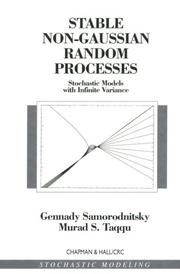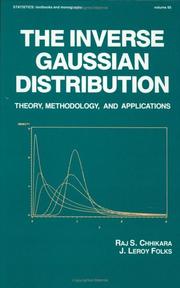| Listing 1 - 10 of 59 | << page >> |
Sort by
|
Book
ISBN: 1283398427 9786613398420 3110215276 9783110215274 9783110215267 9781283398428 661339842X Year: 2009 Publisher: Berlin Walter de Gruyter
Abstract | Keywords | Export | Availability | Bookmark
 Loading...
Loading...Choose an application
- Reference Manager
- EndNote
- RefWorks (Direct export to RefWorks)
The fourth German edition of this textbook presents the fundamental ideas and results of both probability theory and statistics. It comprises the material of a one-year course, and is addressed to students of mathematics as well as scientists and computer scientists with interest in the mathematical aspects of stochastics.
Stochastic processes. --- Probabilities. --- Statistics. --- Normal Distribution. --- Probability Theory. --- Regression Analysis. --- Stochastics.
Book
Year: 2020 Publisher: Basel, Switzerland MDPI - Multidisciplinary Digital Publishing Institute
Abstract | Keywords | Export | Availability | Bookmark
 Loading...
Loading...Choose an application
- Reference Manager
- EndNote
- RefWorks (Direct export to RefWorks)
In recent years, the advances and abilities of computer software have substantially increased the number of scientific publications that seek to introduce new probabilistic modelling frameworks, including continuous and discrete approaches, and univariate and multivariate models. Many of these theoretical and applied statistical works are related to distributions that try to break the symmetry of the normal distribution and other similar symmetric models, mainly using Azzalini's scheme. This strategy uses a symmetric distribution as a baseline case, then an extra parameter is added to the parent model to control the skewness of the new family of probability distributions. The most widespread and popular model is the one based on the normal distribution that produces the skewed normal distribution. In this Special Issue on symmetric and asymmetric distributions, works related to this topic are presented, as well as theoretical and applied proposals that have connections with and implications for this topic. Immediate applications of this line of work include different scenarios such as economics, environmental sciences, biometrics, engineering, health, etc. This Special Issue comprises nine works that follow this methodology derived using a simple process while retaining the rigor that the subject deserves. Readers of this Issue will surely find future lines of work that will enable them to achieve fruitful research results.
Humanities --- Social interaction --- positive and negative skewness --- ordering --- fitting distributions --- Epsilon-skew-Normal --- Epsilon-skew-Cauchy --- bivariate densities --- generalized Cauchy distributions --- asymmetric bimodal distribution --- bimodal --- maximum likelihood --- slashed half-normal distribution --- kurtosis --- likelihood --- EM algorithm --- flexible skew-normal distribution --- skew Birnbaum–Saunders distribution --- bimodality --- maximum likelihood estimation --- Fisher information matrix --- maximum likelihood estimates --- type I and II censoring --- skewness coefficient --- Weibull censored data --- truncation --- half-normal distribution --- probabilistic distribution class --- normal distribution --- identifiability --- moments --- power-normal distribution --- positive and negative skewness --- ordering --- fitting distributions --- Epsilon-skew-Normal --- Epsilon-skew-Cauchy --- bivariate densities --- generalized Cauchy distributions --- asymmetric bimodal distribution --- bimodal --- maximum likelihood --- slashed half-normal distribution --- kurtosis --- likelihood --- EM algorithm --- flexible skew-normal distribution --- skew Birnbaum–Saunders distribution --- bimodality --- maximum likelihood estimation --- Fisher information matrix --- maximum likelihood estimates --- type I and II censoring --- skewness coefficient --- Weibull censored data --- truncation --- half-normal distribution --- probabilistic distribution class --- normal distribution --- identifiability --- moments --- power-normal distribution
Book
Year: 2020 Publisher: Basel, Switzerland MDPI - Multidisciplinary Digital Publishing Institute
Abstract | Keywords | Export | Availability | Bookmark
 Loading...
Loading...Choose an application
- Reference Manager
- EndNote
- RefWorks (Direct export to RefWorks)
In recent years, the advances and abilities of computer software have substantially increased the number of scientific publications that seek to introduce new probabilistic modelling frameworks, including continuous and discrete approaches, and univariate and multivariate models. Many of these theoretical and applied statistical works are related to distributions that try to break the symmetry of the normal distribution and other similar symmetric models, mainly using Azzalini's scheme. This strategy uses a symmetric distribution as a baseline case, then an extra parameter is added to the parent model to control the skewness of the new family of probability distributions. The most widespread and popular model is the one based on the normal distribution that produces the skewed normal distribution. In this Special Issue on symmetric and asymmetric distributions, works related to this topic are presented, as well as theoretical and applied proposals that have connections with and implications for this topic. Immediate applications of this line of work include different scenarios such as economics, environmental sciences, biometrics, engineering, health, etc. This Special Issue comprises nine works that follow this methodology derived using a simple process while retaining the rigor that the subject deserves. Readers of this Issue will surely find future lines of work that will enable them to achieve fruitful research results.
Humanities --- Social interaction --- positive and negative skewness --- ordering --- fitting distributions --- Epsilon-skew-Normal --- Epsilon-skew-Cauchy --- bivariate densities --- generalized Cauchy distributions --- asymmetric bimodal distribution --- bimodal --- maximum likelihood --- slashed half-normal distribution --- kurtosis --- likelihood --- EM algorithm --- flexible skew-normal distribution --- skew Birnbaum–Saunders distribution --- bimodality --- maximum likelihood estimation --- Fisher information matrix --- maximum likelihood estimates --- type I and II censoring --- skewness coefficient --- Weibull censored data --- truncation --- half-normal distribution --- probabilistic distribution class --- normal distribution --- identifiability --- moments --- power-normal distribution
Book
Year: 2020 Publisher: Basel, Switzerland MDPI - Multidisciplinary Digital Publishing Institute
Abstract | Keywords | Export | Availability | Bookmark
 Loading...
Loading...Choose an application
- Reference Manager
- EndNote
- RefWorks (Direct export to RefWorks)
In recent years, the advances and abilities of computer software have substantially increased the number of scientific publications that seek to introduce new probabilistic modelling frameworks, including continuous and discrete approaches, and univariate and multivariate models. Many of these theoretical and applied statistical works are related to distributions that try to break the symmetry of the normal distribution and other similar symmetric models, mainly using Azzalini's scheme. This strategy uses a symmetric distribution as a baseline case, then an extra parameter is added to the parent model to control the skewness of the new family of probability distributions. The most widespread and popular model is the one based on the normal distribution that produces the skewed normal distribution. In this Special Issue on symmetric and asymmetric distributions, works related to this topic are presented, as well as theoretical and applied proposals that have connections with and implications for this topic. Immediate applications of this line of work include different scenarios such as economics, environmental sciences, biometrics, engineering, health, etc. This Special Issue comprises nine works that follow this methodology derived using a simple process while retaining the rigor that the subject deserves. Readers of this Issue will surely find future lines of work that will enable them to achieve fruitful research results.
positive and negative skewness --- ordering --- fitting distributions --- Epsilon-skew-Normal --- Epsilon-skew-Cauchy --- bivariate densities --- generalized Cauchy distributions --- asymmetric bimodal distribution --- bimodal --- maximum likelihood --- slashed half-normal distribution --- kurtosis --- likelihood --- EM algorithm --- flexible skew-normal distribution --- skew Birnbaum–Saunders distribution --- bimodality --- maximum likelihood estimation --- Fisher information matrix --- maximum likelihood estimates --- type I and II censoring --- skewness coefficient --- Weibull censored data --- truncation --- half-normal distribution --- probabilistic distribution class --- normal distribution --- identifiability --- moments --- power-normal distribution
Book
ISBN: 0387970622 3540970622 1461396573 1461396557 9783540970620 9780387970622 Year: 1990 Publisher: New York Springer
Abstract | Keywords | Export | Availability | Bookmark
 Loading...
Loading...Choose an application
- Reference Manager
- EndNote
- RefWorks (Direct export to RefWorks)
Probability theory --- Multivariate Analysis --- Normal Distribution --- Distribution (Probability theory) --- Multivariate analysis --- Distribution (Théorie des probabilités) --- Analyse multivariée --- Multivariate analysis. --- Distribution (Probability theory). --- Distribution (Théorie des probabilités) --- Analyse multivariée --- Multivariate Analysis. --- Normal Distribution.

ISBN: 0412051710 9780412051715 Year: 2000 Publisher: Boca Raton, Fla Chapman & Hall
Abstract | Keywords | Export | Availability | Bookmark
 Loading...
Loading...Choose an application
- Reference Manager
- EndNote
- RefWorks (Direct export to RefWorks)
Stochastic processes --- Gaussian distribution --- Gaussian processes --- Gauss, loi de (Statistique) --- Processus gaussiens --- 519.2 --- Normal distribution --- Distribution (Probability theory)
Book
ISBN: 0821830082 Year: 1971 Publisher: Providence (R.I.): American Mathematical Society
Abstract | Keywords | Export | Availability | Bookmark
 Loading...
Loading...Choose an application
- Reference Manager
- EndNote
- RefWorks (Direct export to RefWorks)
Book
ISBN: 9001585604 9401023603 9401023581 9789001585600 Year: 1973 Publisher: Leiden Noordhoff
Abstract | Keywords | Export | Availability | Bookmark
 Loading...
Loading...Choose an application
- Reference Manager
- EndNote
- RefWorks (Direct export to RefWorks)
Probability theory --- Probabilities --- Probabilités --- Problems, exercises, etc. --- Problèmes et exercices --- Problems, exercises, etc --- 519.213 --- -Probability --- Statistical inference --- Combinations --- Mathematics --- Chance --- Least squares --- Mathematical statistics --- Risk --- Probability distributions and densities. Normal distribution. Characteristic functions. Measures of dependence. Infinitely divisible laws. Stable laws --- -Probability distributions and densities. Normal distribution. Characteristic functions. Measures of dependence. Infinitely divisible laws. Stable laws --- 519.213 Probability distributions and densities. Normal distribution. Characteristic functions. Measures of dependence. Infinitely divisible laws. Stable laws --- -519.213 Probability distributions and densities. Normal distribution. Characteristic functions. Measures of dependence. Infinitely divisible laws. Stable laws --- Probability --- Probabilités --- Problèmes et exercices --- Probabilités. --- Probabilities - Problems, exercises, etc --- Probabilités.
Book
ISBN: 0852642717 9780852642719 Year: 1983 Publisher: London Griffin
Abstract | Keywords | Export | Availability | Bookmark
 Loading...
Loading...Choose an application
- Reference Manager
- EndNote
- RefWorks (Direct export to RefWorks)
Mathematical analysis --- Probability theory --- 519.213 --- #TELE:SISTA --- Probability distributions and densities. Normal distribution. Characteristic functions. Measures of dependence. Infinitely divisible laws. Stable laws --- 519.213 Probability distributions and densities. Normal distribution. Characteristic functions. Measures of dependence. Infinitely divisible laws. Stable laws

ISBN: 0824779975 9780824779979 Year: 1989 Volume: v. 95 Publisher: New York (N.Y.): Dekker
Abstract | Keywords | Export | Availability | Bookmark
 Loading...
Loading...Choose an application
- Reference Manager
- EndNote
- RefWorks (Direct export to RefWorks)
Stochastic processes --- Inverse Gaussian distribution. --- Inverse Gaussian distribution --- 519.213 --- Gaussian distribution, Inverse --- Distribution (Probability theory) --- Probability distributions and densities. Normal distribution. Characteristic functions. Measures of dependence. Infinitely divisible laws. Stable laws --- 519.213 Probability distributions and densities. Normal distribution. Characteristic functions. Measures of dependence. Infinitely divisible laws. Stable laws
| Listing 1 - 10 of 59 | << page >> |
Sort by
|

 Search
Search Feedback
Feedback About UniCat
About UniCat  Help
Help News
News